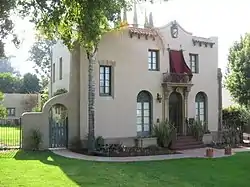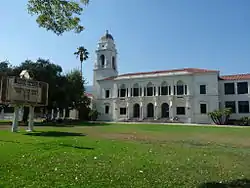Monrovia, California
Monrovia is a city in the foothills of the San Gabriel Mountains in the San Gabriel Valley of Los Angeles County, California, United States. The population was 37,931 at the 2020 census.[5] Monrovia has been used for filming TV shows, movies and commercials.
Monrovia, California | |
|---|---|
 I-210 in Monrovia with San Gabriel Mountains in the background | |
 Flag 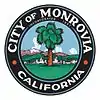 Seal | |
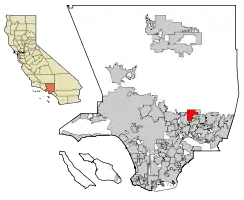 Location of Monrovia in Los Angeles County, California | |
 Monrovia, California Location in the United States | |
| Coordinates: 34°8′45.28″N 118°0′3.42″W | |
| Country | United States |
| State | California |
| County | Los Angeles |
| Incorporated | December 15, 1887[1] |
| Government | |
| • Type | Council-Manager |
| • Mayor | Becky A. Shevlin |
| • Mayor Pro Tem | Larry Spicer |
| • City Council |
|
| • City Manager | Dylan Feik |
| • City Treasurer | Janet Wall[2] |
| Area | |
| • Total | 13.74 sq mi (35.59 km2) |
| • Land | 13.63 sq mi (35.31 km2) |
| • Water | 0.11 sq mi (0.28 km2) 0.79% |
| Elevation | 571 ft (174 m) |
| Population | |
| • Total | 37,931 |
| • Density | 2,782/sq mi (1,074.2/km2) |
| Time zone | UTC−8 (PST) |
| • Summer (DST) | UTC−7 (PDT) |
| ZIP Codes | 91016–91017 |
| Area code | 626 |
| FIPS code | 06-48648 |
| GNIS feature ID | 1661049 |
| Website | www |
History
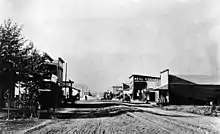
Monrovia is the fourth-oldest general-law city in Los Angeles County and the L.A. Basin (after Los Angeles, Santa Monica, and Pasadena, all now charter cities[6]). Incorporated in 1887, it has grown from a sparse community of orange ranches to a residential community of over 37,000.
Around 500 BC, the Tongva, a band of Shoshonean-speaking Indians, established settlements in what is now the San Gabriel Valley. They were called the Gabrieliño Indians by early Spanish missionaries, a tribe of Mission Indians. The Tongva were not farmers; they gathered wild seeds, berries, and plants along rivers and in marshlands. Abundant oaks in the Valley, such as Coast Live Oak and Interior Live Oak, provided a staple of the Tongva diet: acorn mush made of boiled acorn flour.
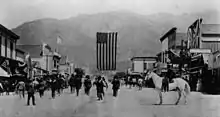
In 1769, the Portolà expedition was the first recorded Spanish (or any European) land entry and exploration of present-day California, then the Spanish colonial Las Californias Province of the Viceroyalty of New Spain (colonial México). In 1542, Juan Rodríguez Cabrillo claimed it from sea for the King of Spain. The expedition led by Gaspar de Portolà proceeded north from San Diego, passing through the area en route to Monterey Bay. Accompanying Portolà was Franciscan padre Juan Crespí, the expedition's diarist. Much of what is known of early California is from Crespi's detailed descriptions.
In 1771, Franciscans established the Mission San Gabriel Arcangel in the San Gabriel Valley. The mission continued after Mexican independence in 1822. In 1833, the Mexican Congress initiated secularization of the missions in Alta California, to begin seizure of mission properties for sale to private rancho grantees.
In 1841, Alta California Governor Juan Alvarado issued Mexican land grants for Rancho Azusa de Duarte to Andrés Duarte, a Mexican soldier; and for Rancho Santa Anita to Hugo Reid, a naturalized Mexican citizen of Scottish birth. Monrovia is made of parts of these two ranchos.
In the mid-19th century, most of Rancho Azusa de Duarte was subdivided and sold by Duarte to settle his debts. Some of those parcels became part of the ranch of William N. Monroe, Monrovia's eponym.
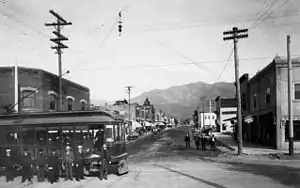
Rancho Santa Anita changed hands several times before the multimillionaire, silver baron and rancher E.J. "Lucky" Baldwin acquired it in 1875. That same year his Los Angeles Investment Company began subdividing and selling parcels from many of his ranchos. In 1883, 240 acres (970,000 m2) of Rancho Santa Anita were sold to Monroe for $30,000. Additional parcels of Rancho Santa Anita were sold to Edward F. Spence, John D. Bicknell, James F. Crank, and J.F. Falvey.
The completion of the Los Angeles and San Gabriel Valley Railroad in 1887, later sold to the Santa Fe (which would run through Monrovia) and Southern Pacific railroads to Southern California brought new people looking for homes and investment opportunities. With this in mind, Monroe, Spence, Bicknell, Crank, and Falvey combined their land under the business name of the Monrovia Land and Water Company in 1886, centered at Orange (now Colorado Boulevard) and Myrtle Avenues; the first tract extended from Magnolia Avenue on the west to Charlotte Avenue (Canyon Boulevard) on the east, a half block south of Walnut on the south and a half block north of Lime on the north.[7] The subdivision was subdivided into 600 500-foot (150 m) by 160-foot (49 m) (1.84 acre) lots and sold.
The town was incorporated in 1887 under the leadership of prohibitionists who wished to control the arrival of an unwelcome saloon. The newly formed government's first order of business was to pass a tippler's law, prohibiting the sale of alcohol.
In 1903, the Monrovia News was established. The same year, the Pacific Electric was opened, providing transportation to and from Los Angeles, making it possible for Monrovia homeowners to work in Los Angeles.

In 1905, Carnegie funds became available and, with the help of the Board of Trade (forerunner to the Chamber of Commerce) and the Monrovia Women's Club, a bond issue was passed to purchase the Granite Bank Building to be used as a city hall, and to acquire property for a public park. The Granite Building has served as the city hall, fire and police department facilities since 1961 and the fire department since 1974. In 1956, the old Carnegie library building was torn down and a new library was constructed. In March 2007, a new library was voted on by the people of Monrovia. It won with 70% yes votes. The library now has 190,000 books, a heritage room for historical documents, and areas for children, teens, and adults.[8]
A city council–manager type government was instituted in 1923.
In 1930, the Monrovia Airport, also known as the Foothill Flying Club, was commercially established. The small airstrip claimed to have had 12,000 paying customers use the airfield in 1932 and on May 19, 1938, the first airmail flight took off from Monrovia Airport. Ownership of the airport changed hands several times while it was in operation; pilots remembered it as "the friendliest little airport in the country." Apart from usage by Riley Brothers, TWA Captain and former airshow pilot Kalman Irwin, and Pancho Barnes, the airfield is well known for its use as a movie-filming location. The first movie filmed at the Monrovia Airport was The Fighting Pilot. Other films shot at the airfield include 20,000 Men a Year, The Great Plane Robbery, and most notably, The Big Noise, featuring Laurel and Hardy. The 35-acre airfield, used as a runway as well as an airplane repair and storage service, was forced to close in 1953 after being sold to Consolidated Engineering Corporation for redevelopment as a result of increased land values.[9]
Monrovia was the home to the precursor to McDonald's. In 1937, Patrick McDonald opened a food stand on Huntington Drive (Route 66) near the old Monrovia Airport called "The Airdrome" (hamburgers were ten cents, and all-you-can-drink orange juice was five cents); it remained there until 1940, when he and his two sons, Maurice and Richard, moved the building 40 miles (64 km) east to San Bernardino to the corner of West 14th Street and 1398 North E Street, renaming it "McDonald's".
The Upton Sinclair House, home to activist and author Upton Sinclair, is in Monrovia and is a National Historic Landmark. In 1995, Monrovia received the All America City Award from the National Civic League.
Geography
According to the United States Census Bureau, the city has an area of 35.5 square kilometers (13.7 sq mi). 13.6 square miles (35 km2) of it is land and 0.1 square miles (0.26 km2) of it (0.79%) is water.[10] Wildlife from the San Gabriel Mountains, including bears, bobcats, foxes, and mountain lions, roams some neighborhoods.[11]
Demographics
| Census | Pop. | Note | %± |
|---|---|---|---|
| 1890 | 907 | — | |
| 1900 | 1,205 | 32.9% | |
| 1910 | 3,576 | 196.8% | |
| 1920 | 5,480 | 53.2% | |
| 1930 | 10,890 | 98.7% | |
| 1940 | 12,807 | 17.6% | |
| 1950 | 20,186 | 57.6% | |
| 1960 | 27,079 | 34.1% | |
| 1970 | 30,562 | 12.9% | |
| 1980 | 30,531 | −0.1% | |
| 1990 | 35,761 | 17.1% | |
| 2000 | 36,929 | 3.3% | |
| 2010 | 36,590 | −0.9% | |
| 2020 | 37,931 | 3.7% | |
| U.S. Decennial Census[12] | |||
2010
The 2010 United States Census[13] reported that Monrovia had a population of 36,590. The population density was 2,668.1 inhabitants per square mile (1,030.2/km2). The racial makeup of Monrovia was 21,932 (59.9%) White (41.1% Non-Hispanic White),[14] 4,107 (11.2%) Asian, 2,500 (6.8%) African American, 279 (0.8%) Native American, 76 (0.2%) Pacific Islander, 5,818 (15.9%) from other races, and 1,878 (5.1%) from two or more races. Hispanic or Latino of any race were 14,043 persons (38.4%).
The census reported that 36,434 people (99.6% of the population) lived in households, 61 (0.2%) lived in non-institutionalized group quarters, and 95 (0.3%) were institutionalized.
There were 13,762 households, out of which 4,725 (34.3%) had children under the age of 18 living in them, 6,295 (45.7%) were opposite-sex married couples living together, 2,073 (15.1%) had a female householder with no husband present, 778 (5.7%) had a male householder with no wife present. There were 793 (5.8%) unmarried opposite-sex partnerships, and 131 (1.0%) same-sex married couples or partnerships. 3,649 households (26.5%) were made up of individuals, and 1,276 (9.3%) had someone living alone who was 65 years of age or older. The average household size was 2.65. There were 9,146 families (66.5% of all households); the average family size was 3.24.
The population was spread out, with 8,514 people (23.3%) under the age of 18, 3,084 people (8.4%) aged 18 to 24, 10,733 people (29.3%) aged 25 to 44, 10,018 people (27.4%) aged 45 to 64, and 4,241 people (11.6%) who were 65 years of age or older. The median age was 37.9 years. For every 100 females, there were 91.6 males. For every 100 females age 18 and over, there were 87.0 males.
There were 14,473 housing units at an average density of 1,055.4 per square mile (407.5/km2), of which 6,809 (49.5%) were owner-occupied, and 6,953 (50.5%) were occupied by renters. The homeowner vacancy rate was 1.3%; the rental vacancy rate was 4.9%. 18,478 people (50.5% of the population) lived in owner-occupied housing units and 17,956 people (49.1%) lived in rental housing units.
According to the 2010 United States Census, Monrovia had a median household income of $71,768, with 9.8% of the population living below the federal poverty line.[14]
2000
As of the census[15] of 2000, there were 36,929 people, 13,502 households, and 9,086 families residing in the city. The population density was 2,686.5 inhabitants per square mile (1,037.3/km2). There were 13,957 housing units at an average density of 1,015.3 per square mile (392.0/km2). The racial makeup of the city was 62.92% White, 8.67% African American, 7.02% Asian, 0.87% Native American, 0.13% Pacific Islander, 15.61% from other races, and 4.77% from two or more races. Hispanic or Latino of any race were 35.24% of the population.
There were 13,502 households, out of which 35.4% had children under the age of 18 living with them, 46.4% were married couples living together, 15.4% had a female householder with no husband present, and 32.7% were non-families. 26.0% of all households were made up of individuals, and 8.8% had someone living alone who was 65 years of age or older. The average household size was 2.71 and the average family size was 3.29.
In the city, the age distribution of the population shows 27.4% under the age of 18, 8.0% from 18 to 24, 34.0% from 25 to 44, 20.2% from 45 to 64, and 10.4% who were 65 years of age or older. The median age was 34 years. For every 100 females, there were 92.2 males. For every 100 females age 18 and over, there were 87.6 males.
The median income for a household in the city was $45,375, and the median income for a family was $49,703. Males had a median income of $41,039 versus $32,259 for females. The per capita income for the city was $21,686. About 9.7% of families and 13.1% of the population were below the poverty line, including 18.3% of those under age 18 and 9.7% of those age 65 or over.
Government and infrastructure
In the California State Legislature, Monrovia is in the 25th Senate District, represented by Democrat Anthony Portantino, and in the 41st Assembly District, represented by Democrat Chris Holden. A small portion of the city is in the 48th Assembly District, represented by Democrat Blanca Rubio.[16]
In the United States House of Representatives, Monrovia is mostly within California's 31st congressional district, represented by Democrat Grace Napolitano with a small portion of the city in California's 28th congressional district, represented by Democrat Judy Chu.[17]
The Los Angeles County Department of Health Services operates the Monrovia Health Center in Monrovia.[18]
Education
Public schools
Monrovia Unified School District operates public schools.
Monrovia High School was built in 1887. It was where Monroe School now stands, and housed the entire elementary and high school student body. A new high school on the property now occupied by Clifton Middle School was erected in 1905, and in 1912 was greatly expanded by the addition of new buildings. In 1928 a high school to serve the communities of Monrovia, Arcadia and Duarte was built. The same structure now serves only Monrovia students, as the elementary and high school district were unified into one district in 1961. The district now has one high school, one continuation school, two middle schools and five elementary schools.
The city's public schools are:
- Bradoaks Elementary School, K-5, 930 E. Lemon
- Canyon Early Learning Center, public pre-K, 1000 South Canyon
- Canyon Oaks High School (public alternative), 7–12, 930 Royal Oaks Drive
- Clifton Middle School, 6–8, 226 S. Ivy
- Mayflower Elementary School, K-5, 210 North Mayflower
- Monroe Elementary School, K-5, 402 W. Colorado
- Monrovia Community Adult School 920 South Mountain
- Monrovia High School 9–12, 845 W. Colorado Boulevard
- Monrovia Mountain School, public Alternative K-8, 950 S. Mountain Avenue
- Plymouth Elementary K-5, 1300 Boley Street
- Santa Fe Middle School 6–8, 148 W. Duarte Road
- Serendipity Early Care and Education Center, K, 940 W. Duarte Road
- Wild Rose Elementary, A California Distinguished School K-5, 232 Jasmine
- Vista Ridge Academy, 1311S. Shamrock
Private schools
- Calvary Road Baptist Academy, K-12, 319 W. Olive
- Church of the Nazarene, K-6 303 W. Colorado
- First Lutheran School, pre-K-8, 1323 South Magnolia
- First Presbyterian Church Preschool, 101 E. Foothill Boulevard
- Immaculate Conception School, K-8, 726 Shamrock
Lycée International de Los Angeles previously had its San Gabriel Valley campus in Monrovia. It opened in 1990 on the property of the United Methodist Church.[19] Its area campus moved to Pasadena in 2006.[20]
Miscellaneous education
- Joe Ferrante Music Academy, K-12, 126 E. Colorado Blvd.
Colleges and universities
The city is a part of the Citrus Community College District.
Media
Monrovia community news is provided by the San Gabriel Valley Tribune, published by Digital First Media, and Monrovia Weekly, a community newspaper published by Beacon Media News. Both newspapers have offices in Monrovia. Public access television is provided by KGEM-TV, which is available primarily to cable viewers, with some content online.[21]
Transportation
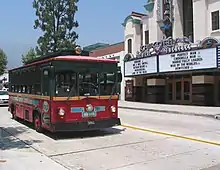
Monrovia's main roads include Foothill Boulevard and Huntington Drive (historic Route 66). It is also served by the Foothill Freeway (I-210).
In 2016, Metro opened a new at-grade light rail station in Monrovia, Monrovia station, at the intersection of Myrtle Avenue and Duarte Road. It is served by the Metro A Line.[22] It is at the location of the former Santa Fe Depot, which still stands.[23]
Economy
Original Tommy's, Trader Joe's, Green Dot and Naked Juice are based in Monrovia. Monrovia has a "Technology Corridor,"[24] primarily on Huntington Drive (old Route 66) east of Primrose Avenue,[25] which includes AeroVironment, Tanner Research, Parasoft, Xencor, and ITT Deep Space Division.
Top employers
According to the city's 2021 Annual Comprehensive Financial Report,[26] the top employers in the city are:
| # | Employer | # of employees |
|---|---|---|
| 1 | Monrovia Unified School District | 724 |
| 2 | Trader Joe's | 341 |
| 3 | STAAR Surgical | 254 |
| 4 | Sierra Autocars | 244 |
| 5 | City of Monrovia | 238 |
| 6 | WorleyParsons | 218 |
| 7 | Home Depot | 209 |
| 8 | Ducommun | 182 |
| 9 | Vinyl Technology | 179 |
| 10 | Amada Myachi America | 164 |
Popular culture
- The house seen in the 1986 horror-comedy cult film House is at 329 Melrose Avenue in Monrovia.[27]
- The exterior house seen in the 2018 post-apocalyptic horror thriller film Bird Box, which was streamed worldwide on Netflix, is at 304 North Canyon Boulevard and the corner of East Greystone Avenue in Monrovia.[28]
Notable people
- Kenny Baker, singer and actor
- Corie Blount, basketball player, Los Angeles Lakers, Chicago Bulls
- Cisco Carlos, Major League Baseball pitcher
- Jason Earles, actor
- Mary Ford, vocalist and guitarist
- Jim Fuller, guitarist for The Surfaris (of "Wipeout" fame)
- Prince Gomolvilas, playwright
- Dean R. Hirsch, president of World Vision International
- Ernie Johnson, former baseball player and member of the New York Yankees first World Series championship team 1923
- Ian Johnson, American football player
- Katie Johnson, Mexican-American soccer player for the San Diego Wave in the NWSL
- Steven Kiyoshi Kuromiya, gay rights activist
- Ellis McCarthy, defensive tackle for Miami Dolphins
- Corky King, founder of Summum
- Scott Land, puppeteer/actor
- Don Mankiewicz, screenwriter and novelist
- Francis M. Pottenger, Jr., nutrition researcher
- Kim Rhode, three-time Olympic gold medalist (six medals total) in trap and skeet shooting
- Thomas J. Sargent, 2011 Nobel Prize in Economics, graduated from Monrovia High School in 1961
- Upton Sinclair and Mary Craig Sinclair, authors and producers
- Jacob Smith, actor
- William A. Spinks (1865–1933), champion carom billiards pro, co-inventor of modern billiards cue chalk, oil investor, and flower and avocado farmer (developer of the Spinks avocado cultivar); also maintained home and farm in nearby Duarte
- Leslie Van Houten, Monrovia High School graduate, Charles Manson follower
- Henry B. Walthall (1878-1936), actor
- The Fabulous Wonder Twins, entertainers
- Ashley Sanchez Professional Soccer Player for the Washington Spirit in the NWSL and the USWNT
See also
References
- "California Cities by Incorporation Date". California Association of Local Agency Formation Commissions. Archived from the original (Word) on November 3, 2014. Retrieved August 25, 2014.
- California League of Cities, Elected City Treasurers Archived February 12, 2012, at the Wayback Machine
- "2019 U.S. Gazetteer Files". United States Census Bureau. Retrieved July 1, 2020.
- "Monrovia (city) QuickFacts". United States Census Bureau. Archived from the original on April 16, 2015. Retrieved April 16, 2015.
- "Census - Geography Profile: Monrovia city, California". United States Census Bureau. Retrieved February 8, 2022.
- "Charter_Cities List". League of California Cities. League of California Cities. Retrieved July 9, 2017.
- "Archived copy" (PDF). Archived from the original (PDF) on March 4, 2016. Retrieved December 8, 2018.
{{cite web}}: CS1 maint: archived copy as title (link) - "Monrovia Public Library — Monrovia Patch — Patch.com". Monrovia.patch.com. January 27, 2011. Retrieved July 1, 2013.
- "Abandoned & Little-Known Airfields: California, East Los Angeles area".
- Money, Luke (February 21, 2020). "'Old lady' bear tranquilized after walkabout in Monrovia neighborhood". Los Angeles Times. Retrieved February 22, 2020.
- Rand, Jory (December 27, 2022). "Mountain lion sighting in Monrovia sparks excitement as SoCal mourns loss of P-22 | abc7.com". ABC 7. Retrieved December 28, 2022.
- "Census of Population and Housing". Census.gov. Retrieved June 4, 2015.
- "2010 Census Interactive Population Search: CA - Monrovia city". U.S. Census Bureau. Archived from the original on July 15, 2014. Retrieved July 12, 2014.
- "US Census Quick Facts". Archived from the original on April 16, 2015. Retrieved December 8, 2018.
- "U.S. Census website". United States Census Bureau. Retrieved January 31, 2008.
- "Statewide Database". Regents of the University of California. Archived from the original on February 1, 2015. Retrieved March 31, 2015.
- "Communities of Interest - City". California Citizens Redistricting Commission. Archived from the original on September 30, 2013. Retrieved September 27, 2014.
- "Monrovia Health Center." Los Angeles County Department of Health Services. Retrieved on March 27, 2010.
- Klein, Karen E. "Monrovia Will Get a Taste of France With New School" (Archive). Los Angeles Times. June 20, 1990. Retrieved on June 29, 2015.
- "Pasadena Campus Archived July 1, 2015, at the Wayback Machine." Lycée International de Los Angeles. Retrieved on June 29, 2015.
- "About KGEM-TV". Archived from the original on January 1, 2017. Retrieved February 8, 2018.
- "Foothill Gold Line Pasadena to Azusa". Retrieved February 8, 2018.
- "Here's what developers are planning for Monrovia's restored 1926 Santa Fe train depot". December 6, 2017. Retrieved February 8, 2018.
- "Technology Corridor". Cityofmonrovia.ws. Archived from the original on March 16, 2012. Retrieved July 1, 2013.
- "City of Monrovia General Plan Amendment Land Use Element". April 1, 2015. Retrieved February 8, 2018.
- "City of Monrovia Annual Comprehensive Financial Report". City of Monrovia. June 30, 2021. Retrieved May 24, 2022.
- "Film locations for House (1986)". Movie-locations.com. Retrieved July 1, 2013.
- "Bird Box (2018) Film Locations". globalfilmlocations.net. Retrieved March 9, 2023.
External links
- Official website City of Monrovia website
- . Encyclopedia Americana. 1920.
